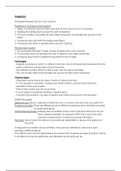Summary
Summary Inventory - Grade 12 IEB Accounting
- Course
- Institution
- Book
Covers the various sections relating to Inventory, as per the IEB Accounting SAG. Includes notes from the textbook, as well as additional class, video and research information. Applicable to all IEB Grade 12s. Written by a 90% < student.
[Show more]




